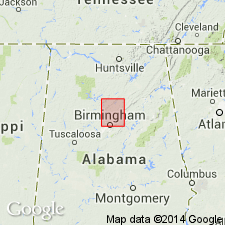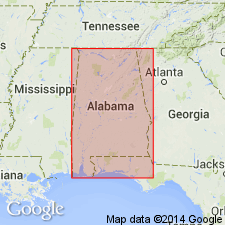
- Usage in publication:
-
- Shades sandstone member*
- Modifications:
-
- Original reference
- Dominant lithology:
-
- Sandstone
- AAPG geologic province:
-
- Appalachian basin
Summary:
Pg. 10, 11. Shades sandstone member of Pottsville formation. Thick-bedded, rather coarse sandstone, generally somewhat conglomeratic in lower part. Thickness 200 feet. Basal sandstone member of Pottsville formation in Cahaba and Coosa coal fields, [Jefferson County], central Alabama. Either rests on Brock coal or is separated from that coal by 50 feet of shale. Age is Pennsylvanian.
[Named for presence on Shades Mountain, Jefferson Co., central AL.]
[Misprint (US geologic names lexicon, USGS Bull. 896, p. 1963): Shades Mountain is in Jefferson Co., not Jeffersonville Co.]
Source: US geologic names lexicon (USGS Bull. 896, p. 1963).

- Usage in publication:
-
- Shades Sandstone Member*
- Modifications:
-
- Overview
- AAPG geologic province:
-
- Appalachian basin
Summary:
Pg. 78. Shades Sandstone Member of Pottsville Formation. A thick-bedded coarse-grained quartzose sandstone, somewhat conglomeratic at the base, which occurs at the base of the Pottsville in the Coosa and Cahaba coal fields, southern Valley and Ridge province. Maintains an average thickness of about 200 feet throughout the length of the Cahaba field and a thickness of 190 to 500 feet in the Coosa coal field. [Age is Early Pennsylvanian (Morrowan).]
See also Charles Butts, 1910, USGS Geol. Atlas of the US, Birmingham folio, no. 175, p. 10, 11; W.C. Culbertson, 1964, USGS Bull. 1182-B, p. B35, pls. 2, 3.
Source: Publication.
For more information, please contact Nancy Stamm, Geologic Names Committee Secretary.
Asterisk (*) indicates published by U.S. Geological Survey authors.
"No current usage" (†) implies that a name has been abandoned or has fallen into disuse. Former usage and, if known, replacement name given in parentheses ( ).
Slash (/) indicates name conflicts with nomenclatural guidelines (CSN, 1933; ACSN, 1961, 1970; NACSN, 1983, 2005, 2021). May be explained within brackets ([ ]).

